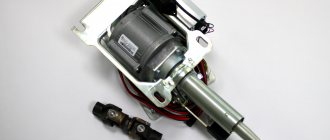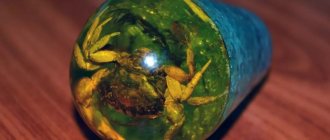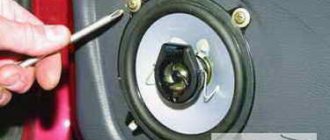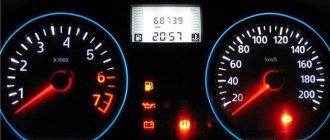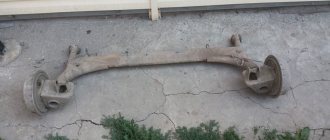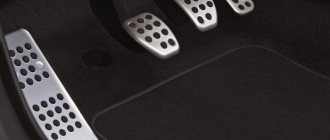- home
- Coolant
- …
We all know the wonderful drug WD-40. This is an aerosol preparation that repels water, prevents corrosion, has lubricating and cleaning properties, most importantly (as it seems to me) it has very good penetrating capabilities (if it is used to treat a rusty threaded connection that “does not give in”, then it can be easily unscrewed), You can’t count all the advantages. This drug was developed by an American company and is sold in almost all countries of the world; any mechanic simply cannot imagine his existence without it! Everything would be fine, but its price is now a little “high”, and if you use it every day and it is used up quickly enough, what should you do? After all, you want to save money! Calmly, you can make an almost complete analogue with your own hands. Today is my signature recipe, which I have been using for several years (plus there will be a video at the end) ...
Of course, prices for WD-40 have now risen following exchange rate fluctuations. Just think about it, a small jar of 100 ml costs about 150 - 200 rubles, but a large 400 ml jar costs from 350 to 400 rubles. NOT CHEAP!
Of course, if you don’t use it every day, but say once a month or several months, then you just bought it and, as they say, “forgot.” But if your job depends on it (foreman at a service station) and you spend it in “liters”! Then you want to save a little, and if you make a worthy analogue with your own hands, it will cost almost 10 times less.
Composition of the original WD 40
This is an interesting nuance that needs to be highlighted. The composition of this “bucket” is very jealously guarded by the manufacturer, thanks to which the WD-40 company still remains the world leader in the manufacture of this spray. Moreover, the company deliberately did not patent this aerosol, so as not to reveal all the secrets of its composition.
However, there is one trick that will help you make this product at home. The original packaging contains a safety data sheet. From it we know that this spray is unusually volatile and flammable. From here we learn the main components, including:
- 50% – gasoline-solvent “white spirit”, which is a mixture of liquid aliphatic and aromatic hydrocarbons, obtained by distillation of oil and often undergoes a hydrotreating procedure;
- 25% – volatile hydrocarbons;
- 15% – mineral oils;
- 10% are inert ingredients that are kept secret by the manufacturer.
This, of course, is not a direct guide to making homemade WD-40, but it still allows you to shed light and select the optimal composition.
What it is
WD40 is positioned as a liquid key.
This is a universal kerosene-based product that can penetrate rusted threaded connections and more. This way you can unscrew oxidized parts without damaging them with excessive physical force.
Therefore, with a huge stretch, a Vedashka can be called a lubricant. No, this is not a lubricant at all in its usual sense.
WD40 is capable of displacing water, dissolving rust and stuck-on elements. Therefore, the product can be called a liquid key or a penetrating lubricant.
To find out the characteristics, you should look at the composition of the product. It is based on kerosene, a certain amount of oil, and a solvent. But there are also auxiliary components.
Analogs of a popular product
The high cost of the original “vedeshka” pushes domestic consumers to look for more affordable analogues. They often succeed, but the cost of saving is a decrease in quality. While real American WD-40 has a powerful water-repellent effect and easily eliminates oxidation of bolted joints, domestic and foreign analogues act much more slowly and are not as effective.
If you are an employee of a service station or a locksmith shop, and your duty requires an incredible amount of this aerosol, then it can be replaced with the following means:
- G-Power (for greater convenience, we give the average cost and volume - 250 rubles / 400 ml);
- 3TON (RUR 150/520 ml);
- ABRO Masters “AB-8” (RUR 335/450 ml);
- CC 1000 (RUR 150/400 ml);
- "Eltrans UPS-40" (108 rub./210 ml).
If you are looking for an analogue with identical composition and quality, it is unlikely that you will be able to find a 100% match. That's why the famous WD-40 is good. But you can try to make it yourself using a popular and proven recipe, which will be given below.
Laxative for nuts
LAXATIVE FOR NUT
LAXATIVE FOR NUT
PENETRATION TEST
TEXT / VLADIMIR ARBUZOV
Unscrewing a thoroughly rusted nut without twisting the “neck” of a bolt or stud is not an easy task. And it would be okay, if the connection is not responsible, you can sacrifice the fasteners. But sometimes, having twisted the stud together with the nut, then, when replacing it with a new one, you will have to disassemble half the machine.
Many ways have been invented to make it easier to deal with stubborn nuts. In the navy, for example, all threaded connections, the mobility of which must be maintained at all times, are “driven” every day in strict accordance with the prescribed sequence. Another radical technique is to heat the stuck nut with an acetylene torch until it turns red. The method is trouble-free, but has drawbacks - you need gas, fire-fighting measures, and you can’t get to every nut with a torch. In addition, annealed fasteners should not be reused.
What if you try to soak the threaded connection with some liquid? Until recently, the car enthusiast had only folk remedies at his disposal - water, kerosene, vinegar essence, iodine, etc. (By the way, Chekhov’s attacker somehow managed without them.) Today the choice is richer - in any store there are a dozen miracle elixirs , called liquid keys. But what is their effectiveness? This is what we decided to check.
We bought 12 different cans (see photo) at prices ranging from 50 (ours) to 260 (imported) rubles. and first of all we cooled them to -15°C. The first test - frost resistance - everyone passed successfully, not a single competitor froze and everyone confidently let out a stream or provided a fine spray, depending on the design of the can.
Required Ingredients
To make your own “bucket”, we recommend taking:
- “White Spirit” - if you are making the product for yourself and will use it once every few months, then feel free to buy a foreign solvent. If you want to save money or assume that you will need a large amount of the final product, then buy Nefras-C4-155/200, it will also work.
- Gasoline "Galosh" - that's what it's called. You can find any other gasoline with increased volatility, but this is the one most often indicated during homemade production. It consists of the very light hydrocarbons that are needed.
- Mineral oil – you can use regular car motor oil. The ideal choice would be 5W-40 and 5W-30. Some craftsmen have experimented with synthetic oil, but it’s better not to take risks.
Now a very interesting nuance. There is an opinion that the original WD-40 contains fish oil. That is why it is often used as bait for large fish. Whether this is true or not - the question remains open. However, when making your own “bucket”, it is still recommended to use an analogue of fish oil - paraffin. You only need a few grams of regular candle wax, not melted.
Important! When making WD-40, never light a candle or melt the paraffin yourself.
It is needed in solid form: white spirit will melt it. Remember that you will be mixing highly flammable ingredients, so any source of open flame is strictly prohibited!
Volatile (light) hydrocarbons
If everything is more or less clear with the other ingredients, I’m talking about oil and YAT-SPIRIT, and finding them is not so difficult!
But with volatile hydrocarbons, it’s not all clear what they are and where to get them.
We begin to remember what it is. According to Wikipedia, light fractions of oil are called volatile (or light), and the most “easily volatile” ones are GASOLINE or gas gasoline. If you don’t have to languish for a long time, you can take regular petroleum ether or the same gasoline.
However, regular gasoline is volatile, but not so much, so we are looking for a special one. And by the way, there is one – it’s GALOSHA gasoline.
If you believe the composition, then it contains light hydrocarbons!
It is used for gasoline lighters, catalytic heaters, and for diluting oil, bitumen and paint compositions.
Popular recipes on how to make WD 40 with your own hands
Now you know the basic composition of a handicraft “bed”, and therefore you can start making it. It is recommended to take the above components with a syringe, especially since it has measuring divisions, which will help you easily select the mass fraction.
It is necessary to mix the components in a small bottle (preferably a glass one, since the solvent can corrode thin plastic). After mixing white spirit, gasoline and mineral oil, add a few pieces of paraffin to them and mix well.
“Vedeshka” is ready! You can safely try it in action by applying a small amount to the rims or to the faucet with limescale. We will talk about application methods at the end, but now we should devote a few words to other well-known recipes for making WD-40.
The composition of a more accurate analogue of this spray (it was developed experimentally) is as follows:
- 45–50% – the same “white spirit”;
- 15–25% – heavy paraffin distillate;
- 12–18% – hydrotreated isoparaffins;
- 2–3% – carbon dioxide.
These ingredients are less accessible to the average consumer and must be mixed in a laboratory setting. Preparing a “vedeshka” according to this recipe requires a lot of knowledge and practice in the field of chemistry, so we do not recommend resorting to this method.
Safety precautions
Working away from an open source of flame is the most important requirement that must be taken into account when making a “bucket” yourself. Remember that your health and even life may depend on this!
Since both white spirit and galosh gasoline are extremely volatile and flammable substances, it is necessary to work away from any heating devices with open elements. These can be powerful lamps and, of course, heaters.
The air temperature should be between –40 and +30 degrees Celsius. It is necessary to work in a well-ventilated area. Of course, you should avoid contact of ingredients with mucous membranes and skin.
Comparison
Since a substance of this type is not the only one of its kind, specialists carried out comparative work.
Drugs with a similar mechanism of action were compared, taking into account the following characteristics:
- ability to protect against corrosion;
- penetrating ability, which allows you to disconnect elements or eliminate squeaking;
- economical consumption;
- presence of a pungent odor;
- efficiency factor (percentage of dry residue);
- convenience of spraying.
How to fill a penetrating lubricant into a can
Now it's time for one little trick. There is no way you can make an aerosol at home, since it requires special equipment. But using a “bucket” in a glass bottle is inconvenient. How to be?
You can resort to a simple method. Pour the prepared solution into a plastic bottle left over from an air freshener or any body care product. Insert an ordinary lever spray bottle into the neck, which can be purchased at any hardware store, and screw the cap tightly.
You now have your own sample of WD-40 ready to use. In conclusion, let’s say that a hand-made “bucket” is much cheaper than the original spray. If its average cost sometimes reaches 350–400 rubles for a 400 ml can, then your spray will cost about 100–150 rubles. The savings are obvious.
The quality of the handicraft “vedeshka” is quite acceptable. If you plan to use this product in the workshop, then it will do and will help you significantly save on costs.
Story
Initially, WD 40 was intended for cleaning various surfaces from stubborn stains. During testing, it turned out that the drug simply amazingly corrodes rust. This allows the liquid to be used when dismantling various structures. The first presentation took place in 1953. After which, the drug was used strictly for military purposes for some time. The first batch went on sale in 1958.
Since then, sales have only grown. The version of the name's appearance is curious. According to one of the creators, the composition was obtained after conducting exactly 40 experiments.


